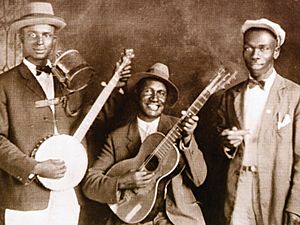Gus Cannon facts for kids
Quick facts for kids
Gus Cannon
|
|
|---|---|

Gus Cannon's Jug Stompers, c. 1928
(Cannon is on the left) |
|
| Background information | |
| Birth name | Gustavus Cannon |
| Also known as | Banjo Joe |
| Born | September 12, 1883 Red Banks, Mississippi, United States |
| Died | October 15, 1979 (aged 96) Memphis, Tennessee, United States |
| Genres | Folk blues |
| Occupation(s) | Musician, sharecropper, labourer |
| Instruments | Banjo, jug, vocals |
| Years active | 1898–1940, 1956–1979 |
| Labels | Victor Records, Paramount, Stax, Folkways |
| Associated acts | Cannon's Jug Stompers |
Gustavus "Gus" Cannon (born September 12, 1883 or 1884 – died October 15, 1979) was an American blues musician. He helped make jug band music popular in the 1920s and 1930s with his group, Cannon's Jug Stompers. There is some debate about his exact birth year, with his tombstone showing 1874.
Contents
Gus Cannon's Musical Journey
Early Life and Learning Music
Gus Cannon was born on a farm in Red Banks, Mississippi. When he was about 12 years old, he moved to Clarksdale. This town was also home to the famous musician W. C. Handy. Gus learned to play music all by himself. He even made his first banjo from a frying pan and a raccoon skin!
At age 15, Gus left home. He started playing music for people at sawmills and at camps where workers built levees and railroads. This was around the early 1900s in the Mississippi Delta area.
While in Clarksdale, two local musicians greatly influenced Gus. Jim Turner played the fiddle in W. C. Handy's band. Gus was so impressed that he decided to learn the fiddle too. Another musician, Alec Lee, played the guitar. He taught Gus his first folk blues song, "Po' Boy, Long Ways from Home." Alec also showed Gus how to use a knife blade as a slide. Gus then used this cool slide technique on his banjo.
Moving to Memphis and Forming Bands
Around 1907, Gus left Clarksdale and settled near Memphis, Tennessee. There, he joined a jug band led by Jim Guffin. He also started playing with Jim Jackson. Gus later met Noah Lewis, who played the harmonica. Noah introduced Gus to a young guitar player named Ashley Thompson. Noah and Ashley would later become members of Gus's own band, Cannon's Jug Stompers. The three of them formed a band and played at parties and dances.
In 1914, Gus began traveling with medicine shows, which were traveling shows that sold medicines. To support his family, Gus worked many jobs. He was a sharecropper (a farmer who pays rent with a share of crops), dug ditches, and did yard work. But music always helped him earn extra money.
Recording Success and Popularity
Gus Cannon started recording music in 1927 under the name Banjo Joe. He recorded for Paramount Records and was joined by Blind Blake. After the Memphis Jug Band became popular with their first records, Gus quickly put together his own jug band. He called it Cannon's Jug Stompers. Noah Lewis and Ashley Thompson were in the band, though Elijah Avery later replaced Ashley.
Their first recordings were made in January 1928 for Victor Records in Memphis. Later, Hosea Woods joined the Jug Stompers. He played guitar, banjo, and kazoo, and also sang. One of Cannon's Jug Stompers' songs, "Big Railroad Blues," can be found on the album The Music Never Stopped: Roots of the Grateful Dead.
Even though they stopped recording in 1930, Cannon's Jug Stompers remained one of the most popular jug bands on Beale Street in Memphis throughout the 1930s. Some of their well-known songs include "Minglewood Blues," "Pig Ankle Strut," "Wolf River Blues," "Viola Lee Blues," "White House Station," and "Walk Right In." "Walk Right In" later became a pop hit for The Rooftop Singers in the 1960s and for Dr. Hook in the 1970s. By the late 1930s, Gus had mostly stopped performing, but he still played music by himself sometimes.
Later Years and Revival
In 1956, Gus recorded a few songs for Folkways Records. During the 1960s, there was a big interest in blues music again. Gus performed at colleges and coffee houses with other blues musicians like Furry Lewis and Bukka White. Sadly, he had to pawn his banjo (sell it temporarily for money) to pay his heating bill the winter before The Rooftop Singers had their big hit with "Walk Right In."
After "Walk Right In" became a hit, Gus recorded a new album in 1963 for Stax Records. He played with other Memphis musicians, including Will Shade (who used to lead the Memphis Jug Band) on jug and Milton Roby on washboard. Gus performed many traditional songs like "Kill It," "Salty Dog," and "Make Me a Pallet on Your Floor." He also played his own song, "Walk Right In," and shared stories between songs.
Gus Cannon also appeared in a movie called Hallelujah! in 1929. He was in a late-night wedding scene.
Passing Away
Gus Cannon passed away in Memphis, Tennessee, on October 15, 1979. He is buried at Greenview Memorial Gardens in Hernando, Mississippi.
Music Albums
Studio Albums
- Walk Right In (Stax, 1963)
- Gus Cannon's Jug Stompers (Roots, 1971)
Compilation Albums
- Cannon's Jug Stompers, The Complete Works in Chronological Order 1927–1930 including Gus Cannon as Banjo Joe (Herwin, 1975)
- Complete Recorded Works in Chronological Order, vols. 1 and 2 (Document, 1990)
- The Legendary 1928–1930 Recordings (JSP, 1994)
- The Best of Cannon's Jug Stompers (Yazoo, 2001)
See also
 In Spanish: Gus Cannon para niños
In Spanish: Gus Cannon para niños

